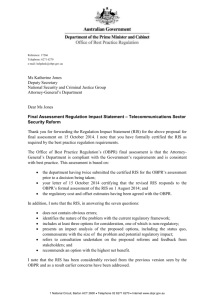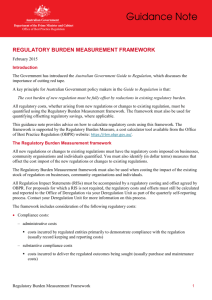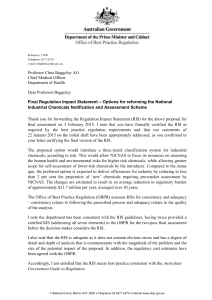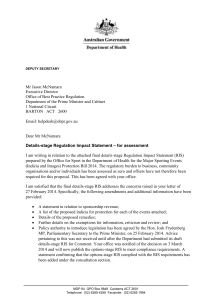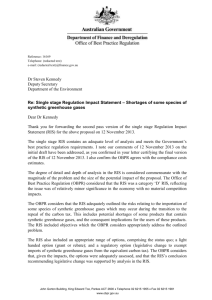Regulatory Burden Measurement Framework
advertisement
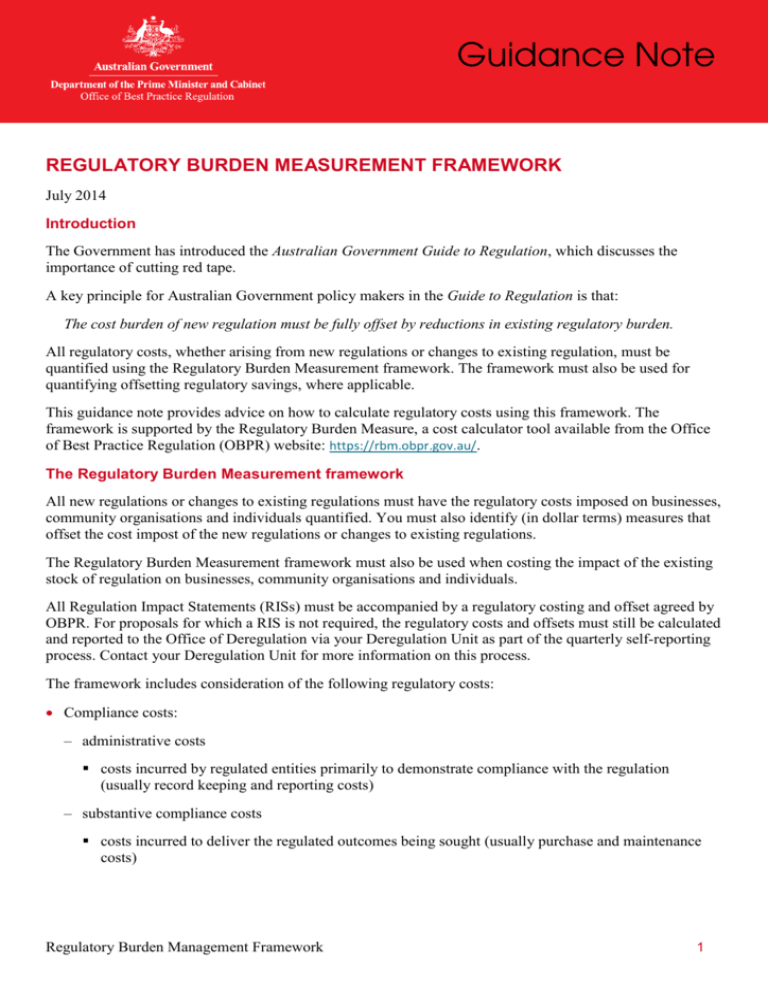
REGULATORY BURDEN MEASUREMENT FRAMEWORK July 2014 Introduction The Government has introduced the Australian Government Guide to Regulation, which discusses the importance of cutting red tape. A key principle for Australian Government policy makers in the Guide to Regulation is that: The cost burden of new regulation must be fully offset by reductions in existing regulatory burden. All regulatory costs, whether arising from new regulations or changes to existing regulation, must be quantified using the Regulatory Burden Measurement framework. The framework must also be used for quantifying offsetting regulatory savings, where applicable. This guidance note provides advice on how to calculate regulatory costs using this framework. The framework is supported by the Regulatory Burden Measure, a cost calculator tool available from the Office of Best Practice Regulation (OBPR) website: https://rbm.obpr.gov.au/. The Regulatory Burden Measurement framework All new regulations or changes to existing regulations must have the regulatory costs imposed on businesses, community organisations and individuals quantified. You must also identify (in dollar terms) measures that offset the cost impost of the new regulations or changes to existing regulations. The Regulatory Burden Measurement framework must also be used when costing the impact of the existing stock of regulation on businesses, community organisations and individuals. All Regulation Impact Statements (RISs) must be accompanied by a regulatory costing and offset agreed by OBPR. For proposals for which a RIS is not required, the regulatory costs and offsets must still be calculated and reported to the Office of Deregulation via your Deregulation Unit as part of the quarterly self-reporting process. Contact your Deregulation Unit for more information on this process. The framework includes consideration of the following regulatory costs: Compliance costs: – administrative costs costs incurred by regulated entities primarily to demonstrate compliance with the regulation (usually record keeping and reporting costs) – substantive compliance costs costs incurred to deliver the regulated outcomes being sought (usually purchase and maintenance costs) Regulatory Burden Management Framework 1 Delay costs: – expenses and loss of income incurred by a regulated entity through: an application delay an approval delay. Administrative costs Administrative costs are costs incurred by regulated entities primarily to demonstrate compliance with the regulation. Some examples of administrative costs are: costs of making, keeping and providing records costs of notifying the Government of certain activities costs of conducting tests costs of making an application compliance costs associated with financial costs, including the costs incurred in complying with government taxes, fees, charges and levies (excluding the actual amount paid)—for example, the time taken to pay a licence fee is a compliance cost. Administrative costs include the time taken to demonstrate compliance with the regulation as well as the associated travel costs (for instance, the costs of travelling to a particular location to submit a form or waiting in a queue in order to comply with a requirement). Substantive compliance costs Substantive compliance costs are costs incurred to deliver the regulated outcomes being sought. Some examples of substantive compliance costs are: costs of providing training to employees to meet regulatory requirements costs of purchasing and maintaining of plant and equipment costs of providing information for third parties, such as providing financial statements to consumers costs of operation (for example, energy costs) costs of professional services needed to meet regulatory requirements (for example legal, tax and accounting advice). Government subsidies paid to assist businesses in complying with a requirement must be subtracted from the compliance cost. Regulatory Burden Management Framework 2 Delay costs Delay costs are the expenses and loss of income incurred by a regulated entity through one or both of: an application delay—the time taken by a regulated entity to complete an administrative application requirement that prevents the party from beginning its intended operations an approval delay—the time taken by the regulator to communicate a decision on an administrative application that prevents the party from beginning its intended operations (this includes the time taken to assess and consider an application). Exclusions from the Regulatory Burden Measurement framework The following costs are excluded from the Regulatory Burden Measurement framework and are not required to be considered in a regulatory costing (however, some of them may need to be considered in the RIS, depending on the significance of that RIS): Opportunity costs (unless they relate to a delay) – Opportunity costs are the value of opportunities that cannot be realised because of the regulatory intervention. Quantifying them can be difficult because of the complexities of accurately predicting what a business would do in response to the removal or lessening of a regulation. The effort required to obtain defensible estimates may be worthwhile when measuring changes to the largest regulatory regimes. Opportunity costs can and should be considered in the context of a full cost–benefit analysis in Long Form RISs. Business-as-usual costs – Regulatory Burden Measurement framework calculations are to measure regulatory burden over and above what a normally efficient business1 would pay in the absence of the regulation. For example, a proposal may require all airports to have a perimeter fence, but that might not result in an increase in regulatory burden if normal business practice in the absence of any regulation is to fence airports. The costs of non-compliance – This includes costs such as fines for failing to comply with a regulation and legal fees, including costs incurred in court and tribunal processes. Regulatory impacts related to the administration of courts and tribunals – This includes changes to the administration of courts and tribunals that are made by the court or tribunal, for example through court rules and practice directions. Indirect costs – These are costs that may arise indirectly from the impacts of regulatory changes, including changes to market structure and competition impacts. 1 A normally efficient business is defined as a regulated entity that handles its regulatory tasks no better or worse than another. Regulatory Burden Management Framework 3 Direct financial costs – These are charges attached to a regulation that are payable to government, such as administrative charges; licence and permit fees; levies; and mandatory insurance premiums (where remitted to government). – Taxes are not within scope of the Regulatory Burden Measurement framework. While taxes are often perceived by business to be a burden, they are a revenue raising measure and not strictly a cost associated with regulation. Costs of international obligations imposed as a prerequisite for participation in international markets – These are the costs of, for example, air worthiness directives. – This exclusion applies only to the cost of performing the obligated activity. It does not exclude the demonstration of compliance where compliance must be demonstrated to a Commonwealth regulator, such as reporting that the airworthiness activity has been completed. Government-to-government regulation – This includes all regulation imposed by the Commonwealth on Australian Government, state and territory government, local government and foreign government departments or agencies, and all of their employees where regulation is imposed on them as part of their employment. However, this exclusion does not apply to: regulation imposed on Government Business Enterprises regulation imposed on businesses owned by foreign governments. Relevant population for assessing regulatory costs The relevant population for the purposes of quantifying regulatory costs can include businesses, community organisations and individuals. An individual is a person who is subject to Australian law, whose activities have an impact in Australia and who either: interacts with the Australian Government, or is affected by an Australian Government regulation. All activities of individuals are captured, including those that are income-generating, such as meeting licensing requirements for employment, and those that do not relate to income, such as obtaining visas and passports. See the Individuals guidance note for further information: http://www.dpmc.gov.au/deregulation/obpr/reportingpublications/publications/guidance/docs/007_Individuals.pdf. Regulatory Burden Management Framework 4 The relevant population also includes businesses or community organisations operating or seeking to operate in Australia, regardless of ownership. This includes: foreign businesses that do not have any operations in Australia exporting to Australia (for example foreign investment applications) Australian businesses or community organisations operating overseas, to the extent that Australian regulations affect their overseas operations. Regulatory burden and cost offset estimate table A regulatory burden and cost offset estimate (RBCOE) table (Table 1) must be populated and reproduced in your RIS (or in the certification letter for an independent review), including for matters that are solely deregulatory. An RBCOE table must be produced for every viable option in the RIS. Where a RIS is not required, costs and offsets are reported directly to the Office of Deregulation through your Deregulation Unit as part of quarterly reporting requirements. Table 1: Regulatory burden and cost offset estimate table Average annual regulatory costs (from business as usual) Change in costs ($ million) Business Community organisations Individuals Total change in costs Total, by sector $ $ $ $ Cost offset ($ million) Business Community organisations Individuals Total, by source Agency $ $ $ $ Are all new costs offset? Yes, costs are offset No, costs are not offset Deregulatory—no offsets required Total (Change in costs – Cost offset) ($ million) = $ Note: where the identified offsets are obtained from outside the agency bringing forward the proposal, extra rows need to be inserted into this table identifying those offsets obtained from within the portfolio (other than from the agency bringing forward the proposal) and those obtained outside the portfolio, as well as a total row. Calculating annual impact You are required to present the average annual impact of the regulatory change in all costings. You should cost your proposal over a 10-year default duration of the regulation. A shorter period may be more appropriate if the proposed regulation is to end sooner, such as for a time-limited grant programme that ends (along with all regulatory costs) after three years. You must have the agreement of OBPR to use timeframes shorter or longer than 10 years. Regulatory Burden Management Framework 5 Costs and offsets are presented as average annual figures in all cases. Discount rates must not be applied to either. For proposals for which the cost does not vary over time, the impact of the change in the first year can be treated as the average annual impact. For proposals that impose varying costs over time, the total change over the duration of the proposal should be divided by that duration to calculate the average annual impact. For one-off and start-up costs, the cost should be divided by the duration of the proposal to calculate the average annual impact. The average annual change in regulatory costs is measured against ‘business as usual’ costs. Therefore, the costs should be the burden over and above what a normally efficient business would pay in costs in the absence of the regulation. Cost offsets When considered with their accompanying offsets, all new regulations must have (at least) a cost-neutral impact on businesses, community organisations and individuals. Therefore, the regulatory cost offsets that you identify must be greater than or equal to the regulatory costs of the new regulation. Cost offsets are required for proposals that increase the total regulatory burden. Deregulatory proposals do not require cost offsets. Cost offsets must be measurable, practical and estimated on the basis of the Regulatory Burden Measurement framework. As with regulatory costs, they should usually be calculated over a 10-year period (but presented in the RBCOE table as average annual figures). You must have the agreement of OBPR to use timeframes shorter or longer than 10 years. Cost offsets are not limited to reductions in legislated regulation. Offsets can be in the form of efficiency benefits to businesses, community organisations and individuals or changes to the way regulation is administered. They are also not constrained to the agency or portfolio, but where possible they must target the same group of stakeholders as the cost impost. For example, a new regulation that has a regulatory burden to small business of $30 million a year should aim to be offset by measures that provide $30 million in cost savings or efficiency benefits to small business over the same period. Where offsets are sourced from another portfolio, agreement must be reached between the relevant ministers and this must be specified in the RIS (or the certification letter for an independent review2). Where offsets are self-assessed, they must be reported to the Office of Deregulation on a quarterly basis. Regulatory offsets that exceed the costs of a new regulatory proposal can be used to offset other regulatory proposals, or can be counted towards the red tape reduction target. However, the balance of those offsets will be applied to the red tape target every 12 months and will then cease to be available to offset new proposals. 2 See the Independent reviews guidance note for more information http://www.dpmc.gov.au/deregulation/obpr/reporting- publications/publications/guidance/docs/015_Independent_reviews.pdf. Regulatory Burden Management Framework 6 Regulatory Burden Measure Agencies are required to use the Regulatory Burden Measure (RBM, formerly known as the Business Cost Calculator) to quantify the costs and cost offsets, unless an alternative is agreed with OBPR. Any alternative must be consistent with the Regulatory Burden Measurement framework. The RBM can be accessed at https://rbm.obpr.gov.au/. An online manual is available at http://www.dpmc.gov.au/deregulation/obpr/rbm/index.cfm. OBPR’s assessment Before a RIS can proceed to the decision maker for a final decision (or be circulated for coordination comments, in the case of Cabinet submissions), the quantification of regulatory costs and regulatory cost offsets must be agreed by OBPR, except for solely deregulatory proposals. For a Final Assessment, you must give OBPR the details of the regulatory costs and offsets at least 10 business days before the RIS is to be provided to the decision maker or circulated for coordination comments. For RISs not subject to a Final Assessment, the regulatory costs and offsets must be provided to OBPR at least five business days before the RIS is to be provided to the decision maker or circulated for coordination comments. OBPR’s agreement to the costing information does not constitute support for the policy or an assessment of the adequacy of the RIS. In assessing the costing information, OBPR asks: Are the assumptions reasonable? How has ‘business as usual’ been defined? How has ‘a normally efficient business’ been defined? Are the data sources referenced? Are there basic errors in the maths? Have offsets been identified? Are the offsets practical? Have the costs and offsets been tested with businesses, community organisations or individuals, as appropriate? OBPR can provide comments on your costings as part of the Early Assessment or Final Assessment process. In assessing whether your RIS meets best practice, OBPR examines whether costs and offsets were agreed by the office and subject to consultation. If costs and offsets were not agreed by OBPR, that could lead to the office assessing your RIS as non-compliant with the RIS requirements. OBPR does not assess costs and offsets outside the RIS process, but is available to provide assistance. Such costs are self-assessed by portfolios using the Regulatory Burden Measurement framework and, once approved by the relevant secretary or deputy secretary, are reported to the Office of Deregulation as part of the quarterly reporting process. Regulatory Burden Management Framework 7 For more information on OBPR assessment, see the User Guide to the Australian Government Guide to Regulation http://www.dpmc.gov.au/deregulation/obpr/reportingpublications/publications/guidance/docs/001_User_Guide.pdf. Solely Deregulatory For proposals that are solely deregulatory and impose no new regulatory costs, the agency can progress to the decision maker without prior OBPR agreement on savings, subject to normal policy approval processes. However, the costings for the savings will need to be agreed within one month of the decision and will be published on the OBPR website. Inter-jurisdictional reforms The net impact of national reforms that result in a change to Commonwealth legislation or practices, or are a result of direct Commonwealth incentives or conditions, should be quantified and offset using the Regulatory Burden Measurement framework. This requirement applies to decisions made by COAG, ministerial councils and intergovernmental standard-setting bodies where there is a level of Commonwealth involvement. Where the Commonwealth does not have 100 per cent control over the governance or regulatory arrangements, the threshold for ‘level of Commonwealth involvement’ is interpreted as the existence of a funding agreement or a degree of influence (such as involvement in a ministerial council). In this case, the responsible Commonwealth portfolio is deemed to be responsible for a portion of burden created or reduced. The exact portion is determined on a case-by-case basis. The costs would need to take into account the costs imposed or removed by the Commonwealth as well as those imposed or removed by states and territories. For example, if as part of a COAG reform the Commonwealth removes regulations, resulting in a reduction of regulatory costs to business of $10 million per year, but as part of the agreed reform states and territories are required to impose additional requirements resulting in new costs to business of $2 million per year, then savings of $8 million per year would be counted towards the Commonwealth’s red tape reduction target. Additional Commonwealth regulation increasing regulatory costs by $10 million per year that results in the states and territories reducing regulatory costs by $8 million per year would require offsetting measures of $2 million per year. Departments should contact their Deregulation Unit, OBPR or both early in the policy making process to determine RIS requirements and whether an inter-jurisdictional reform will need to be measured. OBPR can advise on how the regulatory costings of the reform should be calculated. The portfolio is responsible for the decision on the proportion of costs that should be applied to the Commonwealth target or offset. Further advice on apportioning costs to the Commonwealth target and the associated reporting requirements can be obtained from the Office of Deregulation. For those proposals that may require a COAG RIS, the RIS should be supplemented by additional analysis from the lead Commonwealth department to meet the quantification and offset requirements of the Commonwealth’s red tape reduction programme. The costs need to be agreed by OBPR before a decision is made by COAG, the Ministerial Council or the standard-setting body. Regulatory Burden Management Framework 8 These requirements are not intended to capture all decisions by ministerial councils and intergovernmental standard-setting bodies, especially where the Commonwealth has limited influence over the final decision. They apply to those reforms where the Commonwealth is a party to the reform or where there is a degree of Commonwealth intervention. How to estimate changes in regulatory burden using the RBM Before using the RBM, consider the obligations that are being placed on businesses, community organisations and individuals. Think about administrative, substantive compliance and delay costs that businesses, community organisations and individuals may be facing. For example: What activities will businesses have to undertake under the new or revised regulation? How will community organisations comply with the new or revised regulation? What equipment will businesses have to acquire? What changes to existing processes may be required by individuals? To understand how stakeholders might be affected under a proposed regulation, it is important to identify how they operate in current regulatory or non-regulatory environments. This will help you to identify business-as-usual costs and to quantify changes to the regulatory burden under the proposed regulation. Broadly, there are four steps to be taken in quantifying regulatory costs and cost offsets using the RBM: 1. Consider the nature of the costs (start-up, ongoing fixed/variable). 2. Cost the relevant three regulatory costs (administrative, substantive compliance and delay costs). 3. Estimate cost offsets to businesses, community organisations and individuals. 4. Where a RIS is required, summarise the costs and cost offsets in the RBCOE table for inclusion in the RIS (or certification letter for an independent review), subject to OBPR agreement. Where no RIS is required, report the costs and offsets to the Office of Deregulation as part of the quarterly reporting process. Step 1: Nature of the costs Determine the nature of the costs, which can have a significant impact on the final costing. You should ask: Are the costs start-up or ongoing costs? If the costs are ongoing costs, are they constant or variable? Does the proposal require the quantification of costs by size of business or community organisation? Are the costs start-up or ongoing costs? Start-up costs are costs incurred by stakeholders in the first year of the regulation. They tend to be one-off purchase costs that must be paid to comply with the regulation. Start-up costs are averaged over the life of the regulation in order to calculate the average annual regulatory cost. Regulatory Burden Management Framework 9 Ongoing costs are costs incurred from year to year of the regulation, not just in the first year. The calculation of ongoing costs depends on the whether the ongoing cost is constant or variable. Are the ongoing costs constant or variable? Variable costs are expected to change from year to year. For example, using the default 10-year duration of a regulation, if a business incurs regulatory costs every two years into perpetuity then to calculate the average annual regulatory cost of the proposal the costs over 10 years should be summed and then divided by 10. Do costs vary by size of business or community organisation? Where the effect of an option on businesses or community organisations can vary significantly, consider whether you should disaggregate the sector into small, medium and large cohorts. This will provide you with important information about the regulatory burden on different groups of stakeholders. Step 2: Costing activities Identify each activity that is required to be costed. The three cost categories that should be considered are administrative costs, substantive compliance costs and delay costs. If the cost is an administrative cost, it would normally be considered a labour cost. Substantive compliance costs would normally be purchase costs. The formula used for a labour costs for businesses and community organisations is: Labour cost = Price × Quantity = (Time required × Labour cost) × (Times performed × Number of businesses or community organisations × Number of staff) Where: Time required is the internal time required per staff member, in hours, for businesses or community organisations to perform a regulatory task. Labour cost is the hourly wage rate plus any non-wage costs of employees. The hourly wage rate is the gross wage received by an employee. Non-wage costs of employees should include any on-costs associated with the wage, such as payroll tax and superannuation, as well as any overhead costs such as rent, telephone and IT equipment. Appendix 2 provides more information on labour rates, including the treatment of on-costs and overheads. Times performed is the number of times an activity is performed per year per staff member. For example, if something is required twice a month, the value would be 24. Number of businesses or community organisations is the number affected by a particular regulatory obligation. Consider the expected compliance rate and whether this would have an impact on the number of businesses or community organisations. Number of staff is the number of staff members per business or community organisation who perform the activity. Regulatory Burden Management Framework 10 The formula used for labour costs for individuals is: Labour cost = Price × Quantity = (Time required × Labour cost) × (Times performed × Number of individuals) Where: Labour cost is the rate per hour for individuals not in paid employment or not in the course of their employment (such as leisure time). Unless there is strong evidence to use a different rate, a default rate of $27 per hour should be used. Appendix 2 provides more information on this default rate. Times performed is the number of times an activity is performed per year per individual. Number of individuals is the number affected by a particular regulatory obligation. Consider the expected compliance rate and whether this would have an impact on the number of individuals. The formula used for purchase costs is: Purchase cost = = Price × Quantity (Purchase cost) × (Times performed × Number of businesses or community organisations) Where: Purchase cost is the cost of purchasing a product or purchasing external services (for example, buying a safety guard required by regulation, when the safety guard would not normally have been bought at the start-up of an operation). Measuring delay costs is more complex and might not necessarily involve estimating labour costs or purchase costs. Often, once the regulation is implemented, delay costs could be considered as administrative costs, compliance costs, or both. Delay costs should only be calculated when a business is waiting on government action to commence trading. For example, an entity may have to wait six months to obtain government approvals to sell a product on the Australian market. Where the entity is otherwise able to begin trading on the day it lodges its application, the delay costs comprise lost sales over the six-month approvals period. However, if the entity is not ready to commence trading until four months after lodging the application, the delay costs will comprise only two months of lost sales. Delay costs are often incurred through the holding of land and capital. In these cases, you should be careful to consider what the business-as-usual case (that is, without the proposed regulation) is expected to be and whether the cost is a delay cost, a substantive compliance cost or an administrative cost. As an illustration of this distinction, consider a regulation that results in a business purchasing a machine but, as a result of an application delay, the machine sits idle for two months. The cost of the machine is not considered to be a delay cost, as the machine is needed to comply with the regulation, and would instead be a substantive compliance cost. However, the cost of the machine sitting idle is a delay cost and could be calculated as the loss of income incurred by the business as a result of the machine not being used. Regulatory Burden Management Framework 11 If you believe that a proposed regulation is likely to impose delay costs on businesses, community organisations and individuals, you should contact OBPR for further guidance on incorporating those costs in the RBCOE table in the RIS. Step 3: Cost offsets Cost offsets to businesses, community organisations and individuals must also be estimated using consistent assumptions. The procedures are similar to the ones discussed above. However, the cost offsets must identify the reduction in regulatory costs to business, individuals and community organisations. As with costings of regulatory proposals, understanding the baseline and estimating the change in cost offsets will be important. Step 4: Reporting The RBCOE report must be completed and included in the RIS. Information on costings, such as any assumptions made, must be provided to OBPR for the approval process. Where no RIS is required, costs are self-assessed by portfolios using the Regulatory Burden Measurement framework. Following approval by the relevant secretary or deputy secretary, they reported to the Office of Deregulation as part of the quarterly reporting process. In all cases, the data must be derived using the Regulatory Burden Measurement framework. Further information For further information, including on the use of the RBM, OBPR can be contacted on: Email: helpdesk@obpr.gov.au Phone: 02 6271 6270 Regulatory Burden Management Framework 12 Appendix 1: Frequently asked questions Is quantification of regulatory costs required for all Cabinet submissions? Yes, although the results may be that the final regulatory burden and cost offset output is zero. When is a cost offset not required? A cost offset is not required if the proposed change will result in a reduction in regulatory costs. In the RIS, OBPR must agree that the proposal results in reduced costs. Outside the RIS process, reductions in regulatory costs are self-assessed by portfolios using the Regulatory Burden Measurement framework and, once approved by the relevant secretary or deputy secretary, are reported to the Office of Deregulation as part of the quarterly reporting process Is the use of the Regulatory Burden Measure mandatory? Regulatory costs are required to be estimated using the RBM or using an equivalent method agreed by OBPR. Any alternative method must be consistent with the Regulatory Burden Measurement framework. Are all costs of a regulation required to be quantified in the RBCOE table? No; however, any administrative, substantive compliance and delay costs that you identify and that can be estimated practically should be included. Other impacts, such as opportunity costs or impacts on competition, should be considered in the RIS, and are expected for Long Form RISs as part of a broader cost–benefit analysis. What is the default duration of a regulation? 10 years. What happens if the cost offset is greater than the costs associated with the proposal? Regulatory cost offsets that exceed the costs of the new regulatory proposal can be used to offset other regulatory proposals, or can be counted towards the red tape reduction target. All excess offsets will be reconciled to the target every 12 months. How should the RBCOE table be completed where offsets are obtained outside the agency? For proposals that involve an increase in regulatory costs and the offsets are obtained outside the agency bringing forward the proposal, extra rows will need to be inserted into the RBCOE table identifying those offsets obtained from within the portfolio (other than from the agency bringing forward the proposal) and those obtained outside the portfolio, as well as a total row. For instance, if a proposal increases regulatory costs on businesses by $1 million per year over 10 years and half the identified regulatory cost offsets were obtained within the portfolio but outside the agency while the other half was obtained outside the portfolio, the final RBCOE table should read: Regulatory Burden Management Framework 13 Regulatory burden and cost offset estimate table Average annual regulatory costs (from business as usual) Change in costs ($million) Business Community Organisations Individuals Total change in cost Total, by sector $1 $0 $0 $1 Cost offset ($ million) Business Community organisations Individuals Total, by source Agency $0 $0 $0 $0 Within portfolio $0.5 $0 $0 $0.5 Outside portfolio $0.5 $0 $0 $0.5 Total by Sector $1 $0 $0 $1 Are all new costs offset? Yes, costs are offset No, costs are not offset Deregulatory—no offsets required Total (Change in costs – Cost offset) ($million) = $0 For deregulatory proposals, how should the RBCOE table be completed? For proposals that result in reductions in regulatory burden, the proposal should be entered as a negative in the RBCOE table. For instance, if a proposal saves regulatory costs for business of $400,000 per year over 10 years and there are no identified new regulatory costs at this stage, the final RBCOE table would read: Regulatory burden and cost offset estimate table Average annual regulatory costs (from business as usual) Change in costs ($million) Business Community Organisations Individuals Total change in cost Total, by sector ($0.4) $0 $0 ($0.4) Cost offset ($ million) Business Community organisations Individuals Total, by source Agency $0 $0 $0 $0 Are all new costs offset? Yes, costs are offset No, costs are not offset Deregulatory—no offsets required Total (Change in costs – Cost offset) ($million) = ($0.4) Regulatory Burden Management Framework 14 Appendix 2: Default work-related and non-work-related labour rates The cost of a regulatory proposal that requires individuals to perform a regulatory task, whether as part of their employment in a business or community organisation or as a private citizen in their leisure time, must be estimated using an appropriate labour rate. It is your responsibility to consider the available data to ensure that the estimates are as accurate as possible. Work-related labour costs The labour costs associated with a regulatory task for a business or community organisation are quantified by multiplying the time taken to complete the required compliance activity by the hourly cost to the business or community organisation for the relevant staff. This is the opportunity cost of complying with the regulatory requirement. Where labour-related services are outsourced, such as accountancy or legal services, the cost of those services should be treated as a purchase cost, not a labour cost. The default hourly cost is based on average weekly earnings, but adjusted to include income tax.3 This provides an economy-wide value for employees of $34.20 per hour.4 This value is scaled up using a multiplier of 1.75 (or 75 per cent as it is input into the Regulatory Burden Measure) to account for the nonwage labour on-costs (for example, payroll tax and superannuation) and overhead costs (for example, rent, telephone, electricity and information technology equipment expenses). This default should be used in cases where regulation cuts across a number of sectors, or where more appropriate labour rates are unknown or would add undue complexity to the costing process. Where there is strong evidence that a different wage rate or multiplier is readily available and would be more accurate for work-related labour costs, you should discuss and agree on this with OBPR. For example, you may know the actual overhead and on-costs of the regulated entities, or you may be regulating an individual sector, such as the mining industry or medical practitioners, where a more accurate labour rate proxy for the opportunity cost to the business or community organisation is easily identifiable. Non-work-related labour costs Where proposals involve an impact on individuals not in the course of their employment, this leisure time is assumed to be the opportunity cost of the time spent filling in forms. It is a standard economic approach to consider the trade-off between work and leisure such that the marginal value of time spent working equals the marginal value of time spent at leisure. The marginal value of time spent working is approximated across the economy as the average hourly wage, including overtime, after tax. Therefore, the default value that should be used for an individual’s leisure time is based on average weekly earnings and has been estimated at $27 per hour.5 3 Average weekly earnings estimates are published by the Australian Bureau of Statistics (ABS) net of income tax. 4 Based on ABS, Employee earnings and hours, cat. no. 6306, 2012. Average weekly total cash earnings and hours paid for full-time, non-managerial adult employees, overtime time, persons, all occupations, http://www.abs.gov.au/AUSSTATS/abs@.nsf/Lookup/6306.0Main+Features1May%202012?OpenDocument. Calculated using the ATO’s online Simple Tax Calculator, 2011–12 tax rates. Rates to be reviewed for 2015. 5 Note that this value should only be used to value individuals’ time while not in paid employment for individuals residing in Australia. A more appropriate value should be used when valuing the time of individuals residing outside Australia, depending on the average hourly rate in the country where they are living. Regulatory Burden Management Framework 15 It may not always be the case that the trade-off between work and leisure is applicable to all individuals who are affected by a regulation. This is typically the case for people not in the labour force, such as unemployed people or pensioners. Therefore, where there is strong evidence that a different rate should apply, you should discuss and agree on this with OBPR. Regulatory Burden Management Framework 16
